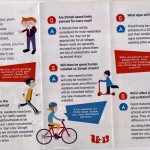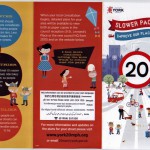The arguments about the introduction of a 20 mph speed limit across the whole of York seem likely to intensify with the publication and distribution by the Council of a highly misleading leaflet on the subject.
The cost of producing and distributing the leaflet is not revealed – a clear breach of the agreement that there would be transparency about such issues. Since 2001 all Council publications have included a line indicating publication costs. Generally publishing a leaflet and delivering to every household costs around £10,000.
The tone of the leaflet is highly patronising and seeks to mislead the public about the level of support for the 20 mph proposal.
It disingenuously quotes 80% support for a 20 mph limit in South Bank without revealing the number who responded to the consultation nor revealing that in 2009 – when the decision to implement a trial 20 mph limit in South Bank was taken – it was in the wake of speed surveys revealing that traffic speeds in the area were already well under 20 mph. The only issue was whether the large cost of putting up 20 mph repeater signs represented a prudent use of taxpayer’s money.
The introduction of 20 mph limits elsewhere in the country, where recorded speeds were already around 20 mph, resulted only in a 1 mph actual reduction in mean speeds.
It would be unsurprising if residents in the South Bank area, which is comprised mainly of relatively narrow terraced streets with large volumes of “on street” parking – which effectively slows traffic , would vote in a way which might be interpreted as encouraging vehicles to travel quicker.
Accident levels in the area were very low with no killed or seriously injured (KSI) victims recorded when the matter was considered in December 2009. There had been some minor accidents and it was hoped that the trial introduction of a lower speed limit would reveal whether these accidents could be eliminated. Prior to the approval of the trial in December 2009, there had been fifteen slight accidents in the previous ten years and five slight accidents in the previous three years.
What changed, was a decision by the new Council in 2011 to include Bishopthorpe Road in the trial. The shopping area might have been included as it was another section of highway where the daytime average recorded speeds were only around 15 mph. This is, again, hardly surprising given the location of the pedestrian crossing, traffic lights and road junctions together with high congestion levels at peak times.
Further up Bishopthorpe Road the situation is very different with this main arterial route being much wider. Additional enforcement action for the 30 mph limit would have been the most obvious first step.
As was reported in December 2009 by Council officials, the vast majority of residents in the majority of wards in York when polled have supported having the most appropriate speed limit to address the individual characteristics of individual roads. The Citywide 20 mph limit has the support of only around 15% of residents.
This is particularly relevant now as the Council begins to try to soften up public opinion in the sector between Tadcaster Road and the Ouse (the Dringhouses, Westfield, Acomb and Holgate wards). The roads in this sector are very different from South Bank, but they will be the next to have a 20 mph limit imposed if the Council goes ahead wiht its plans.
Many have been designed and built since use of motor vehicles became widespread and accident levels on residential roads are very low. Those that have occurred have not generally been the result of excessive speed (In York, KSI accidents are concentrated mainly on trunk roads and in the City centre)
The Council has yet to justify the £600,000 cost of implementing the new limits. The fear remains that with KSI accident numbers beginning to rise last year, if the Council takes its eye off the ball and places exaggerated faith in the effects that 20 mph limit will have, then the hard work, that has been going on for many years to reduce casualties, will be neglected.
The result will be more grief, expense and lost productivity.



You are absolutely correct in highlighting the negative impact of introducing innapropriate speed limits with regard to the upper reaches of Bishopthorpe Road. This policy is sheer lunacy, but unfortunately the climate is one of ‘ If you are against this you don’t care about the kiddies ‘ so all rational argument and judgement is suspended.
I was no supporter of the Lib Dem council but the ruling party have managed to foster contempt for the law as well as City of York Council in many otherwise reasonable and law abiding citizens.
What will never show up in any statistics is the consequences of other rational speed limits being ignored as a result of drivers losing respect for limits in general as a result of inappropriately low ones in the wrong places.
Thank you for your response. We will be opposing any attempt to impose a city wide 20 mph speed limit